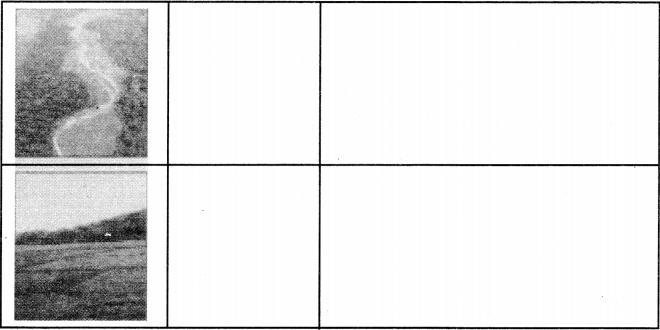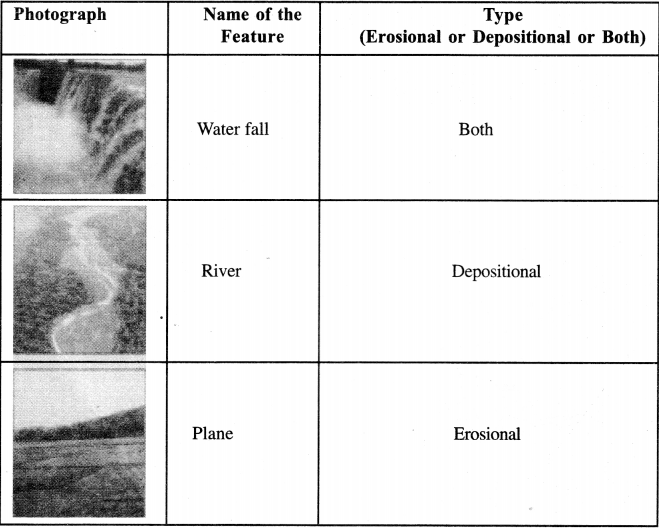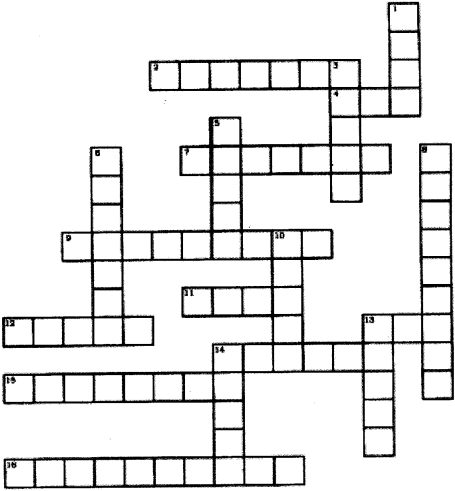Our Changing Earth Class 7 Questions and Answers Geography Chapter 3
Class 7 Geography Chapter 3 NCERT Textbook Questions and Answers
Question 1.
Answer the following questions :
(i) Why do the plates move?
Answer:
The plates move inside the earth because of the movement of the molten magma.
(ii) What are exogenic and endogenic forces?
Answer:
The forces that work on the surface of the earth are called exogenic forces.
The forces which act in the interior of the earth are called endogenic forces.
(iii) What is erosion?
Answer:
Erosion is the wearing away of the landscape by different agents like water, wind and ice.
(iv) How are flood plains formed?
Answer:
The flood plains are formed by the deposition of fine soil particles and other materials called sediments along river banks.
(v) What are sand dunes?
Answer:
Small hills of sands in deserts are called sand dunes. These sand dunes keep on moving from place to place due to fast blowing winds.
(vi) How are beaches formed?
Answer:
The sea waves deposit sediments along the shores forming beaches.
(vii) What are ox-bow lakes?
Answer:
Due to continuous erosion and deposition along the sides of the meanders, the ends of meanders loop come closer and closer. In due course of time, the meander loop cuts off from the river and form a cut off lake which is also called as ox-bow lake.
Question 2.
Tick the correct answer :
(i) Which is not an erosional feature of sea waves?
(a) Cliff
(b) Beach
(c) Sea cave
Answer:
(b) Beach.
(ii) The depositional feature of a glacier is :
(a) Flood plain
(b) Beach
(c) Moraine
Answer:
(c) Moraine.
(iii) Which is caused by the sudden movements of the earth?
(a) Volcano
(b) Folding
(c) Hood plain
Answer:
(b) Folding.
(iv) Mushroom rocks are found in :
(a) Deserts
(b) River Valleys
(c) Glaciers
Answer:
(a) Deserts.
(v) Ox-bow lakes are found in :
(a) Glaciers
(b) River Valleys
(c) Deserts
Ans.
(b) River Valleys
Question 3.
Match the following :
| (i) Glacier | (a) sea shore |
| (ii) Meanders | (b) river of ice |
| (iii) Beach | (c) rivers |
| (iv) Sand dunes | (d) vibrations of earth |
| (v) Waterfall | (e) hard bed rock |
| (vi) Earthquake | (f) deserts |
Answer:
| (i) Glacier | (b) river of ice |
| (ii) Meanders | (c) rivers |
| (iii) Beach | (a) sea shore |
| (iv) Sand dunes | (f) deserts |
| (v) Waterfall | (e) hard bed rock |
| (vi) Earthquake | (d) vibrations of earth |
Question 4.
Give reasons :
1. Some rocks have a shape of a mushroom.
2. Flood plains are very fertile.
3. Sea caves are turned into stacks.
4. Building collapse due to earthquakes.
Answer:
- Some rocks have shape like a mushroom, because winds erode the lower section of the rock more than the upper part.
- Flood plains are very fertile because they are formed by the deposition of the sediments brought by rivers.
- Sea caves turned in to stacks due to erosion.
- When an earthquake occurs, some buildings collapse or fall down due to the vibration of the surface the earth.
Question 5.
Activity :
Observe the photographs given below. These are various features made by a river. Identify them and also tell whether they are erosional or depositional or landforms formed by both.


Answer:

Question 6.
For fun.
Solve the crossword puzzle with the help of given clues.

| Across | Down |
| 2. Loop like bend of river | 1. Rise and fall of water caused by friction of wind on water surface |
| 4. Solid from of water | 3. Flow of water in channel |
| 7. Moving mass of ice | 5. Steep perpendicular face of rock along sea cost |
| 9. Sudden descent of water in bed of river | 6. Debris of boulder and coarse material carried by glacier |
| 11. Natural cavity on weak rocks formed by action of waves | 8. Crescent shaped lake formed by river meander |
| 12. Embankment on river that keeps river in its channel | 10. Fine sand deposited by action of wind |
| 13. Large body of sea water | 13. Isolated mass of rising steep rock near coastline |
| 14. Dry area where sand dunes are found | 14. Alluvial tracts of land at mouth of river formed by river deposits |
| 15. Small hill of sand piled by action of wind | |
| 16. Flat plain formed by river deposits during time of flood |
Answer:
Across:
2. Meander
4. Ice
7. Glacier
11. Cave
12. River
13. Sea
14. Desert
15. Sand dune
16. Flood plain
Down:
1. Wave
3. River
5. Cliff
6. Moraine
8. Ox-bow lake
10. Dunes
13. Beach 14